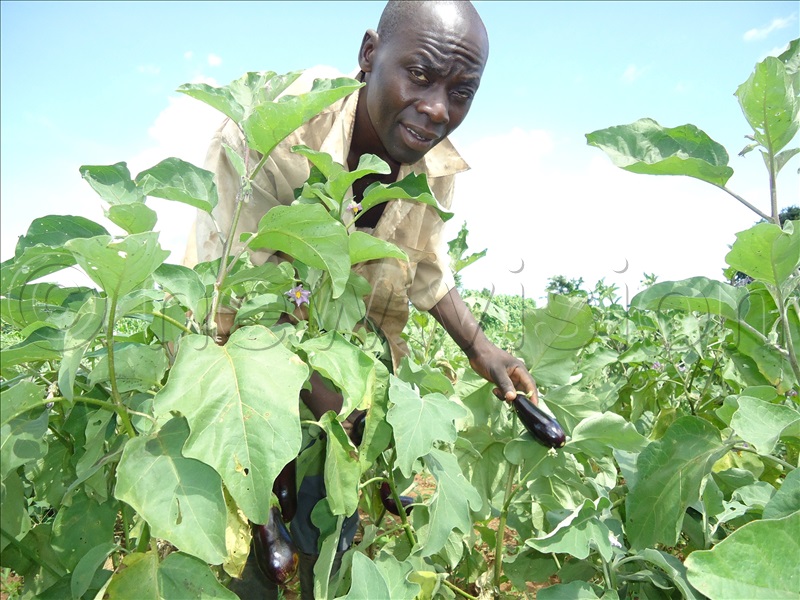By Umar Nsubuga
It is 7:00am on a foggy Wednesday morning. In Buwambo village, about 20 miles away from Kampala, Joseph Mukulu carries a bundle of vegetables on his motor-bike.
He harvested them the evening before and is now headed to Mpererwe, a Kampala suburb to sell them.
Mukulu is one of the thousands of farmers who grow vegetables in a ‘vegetable belt’ that feeds Kampala and its environs.
Mukulu’s bundle of vegetables will find its way to a dinner table in one of the affluent suburbs of the city.

“That is what makes me proud. Knowing that my vegetables are eaten by the affluent in this country,” he says.
The ‘vegetable belt’ runs through Wakiso in areas around Kakiri, Namayumba and Masulita and outskirts around Matugga, Buwambo, Busukuma, Bugema, Busiika, Zirobwe and parts of Kalagi and Nakifuma in Mukono district.
The vegetables are grown along the various small rivers and streams that crisscross these areas.
Every morning and evening, trucks carrying vegetables are seen on the main roads — Gayaza-Zirobwe, Matugga-Semuto and Gayaza-Kalagi to deliver vegetables of various types to Kampala.
The main destinations include Kalerwe, Wandegeya, St Balikudembe and Nakawa markets.

It is not easy to know how many tonnes of vegetables are produced in these areas, however, in the Zirobwe, Bugema and Busukuma areas alone, at least 10 trucks deliver various types of vegetables to city markets every day.
“I take vegetables to Kalerwe twice a week,” says Moses Kizito, who drives a Nissan Sahara.
He delivers an estimated two tonnes per trip.
While there are farmers who grow vegetables on a large scale, most of them are small-scale. The common vegetables are tomatoes, nakati, dodo, bugga, cabbages and green pepper.
While many of them own the small pieces of land on which they grow the vegetables, most of them simply hire land from other farmers.

Mike Nsubuga, 31, a farmer in Katende village, Wakiso district says: “I have been growing indigenous vegetables since 2004. I began by growing cabbages, but because of pest infestation that led to low yields, I decided to focus on growing nakati and eggplants on a large scale.”
Together with his group of five people, they now have about 12 acres located in different parts of Wakiso. All the land is hired at an average of sh150,000 per year.
“I began growing vegetables on only one acre with sh200,000 capital that I invested in purchasing seeds and manure,” Nsubuga says.
Just like most of the farmers here, Nsubuga mainly depends on the weather and the streams to grow vegetables. During the dry season, he waters the vegetables.

Nsubuga says the advantage of growing vegetables is that they mature within a short period and, therefore, bring quick income.
“Nakkati matures within two and a half months during the rainy season but may take three months during the dry season. Bugga, and other vegetables take between two to four months to mature,” he says.
Tomatoes and cabbages take between two and a half and three months.
The farmers apply organic fertilisers to replenish the soil.
“In the start, I used to purchase manure made from chicken droppings and at times cow dung from my neighbours. I used to rent a truck between sh40,000 and sh60,000 because the distance to my gardens is not long. However, it is not always easy to get manure from farmers because they also use it,” he says.

While some of the farmers buy improved high-yielding tomato seeds like Assila, most of them make their vegetable seeds. For example, for nakati, Nsubuga lets it grow to maturity to create seeds.
Most farmers use the ‘broadcasting’ method to grow nakati, dodo and bugga. This is where seeds are scattered randomly around the farm.
This is irrespective of the fact that research recommends planting vegetables in rows because it is easier to control pests.
“Planting in rows is labour-intensive and time-consuming,” says Nsubuga.
But overall, Nsubuga says the business is fulfilling. A small bundle of nakati costs sh500 at the farm.
However, the same bundle costs sh1,000 in Kampala. A farmer can earn between sh2m and sh3m per acre, against a production cost of less than sh500,000
Forming groups
Farmers in parts of Luwero have now formed groups to ‘organise’ their farming.
Denis Kibuuka, the team leader, says they are running almost 12 groups, each comprising 40 members.
In areas such as Nalusugga village, there are four farmer groups. Kibuuka says the project is promising because farmers have a ready market.
He says farming groups will help them easily supply larger markets, such as South Sudan and acquire basic equipment like sprayers.
One of the group members is Agnes Makula. Years ago, she kept cows.
Because of the many challenges she faced, Makula abandoned the practice and joined vegetable growing.
“I supply the local markets with vegetables such as onions, eggplants and tomatoes,” she says.
Other than the open field vegetable growing, she has over 10 sacks filled with soil, where she grows the vegetables.
Her records indicate that last season, she was able to achieve total sales of more than sh2m.
For Makula, Nsubuga and other farmers in the ‘vegetable belt’, may not have physically entered the ‘big houses’ in the affluent suburbs, but they are sure that their vegetables have represented them at the tables in these houses.





